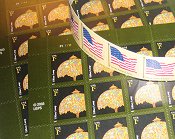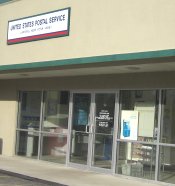- By Dan Veaner
- Around Town
 Print
Print  If you put a 41 cent stamp on a letter this Monday it will be insufficient because the US Postal Service rates are going up. Starting May 12 it will take 42 cents to send a first class letter. Lansing Post Office's Steve Funcell says that people have been coming in early to get one cent stamps so they can use up the 41 cent stamps they already have. But he expects long lines next week when the rates officially go up. ""People will come in and wait in a long line just to buy a few one cent stamps even though it may not be a pressing issue for them," he says. "I think the businesses are more on top of it. It's more of a problem for individuals."
If you put a 41 cent stamp on a letter this Monday it will be insufficient because the US Postal Service rates are going up. Starting May 12 it will take 42 cents to send a first class letter. Lansing Post Office's Steve Funcell says that people have been coming in early to get one cent stamps so they can use up the 41 cent stamps they already have. But he expects long lines next week when the rates officially go up. ""People will come in and wait in a long line just to buy a few one cent stamps even though it may not be a pressing issue for them," he says. "I think the businesses are more on top of it. It's more of a problem for individuals."On July 1, 1885 the rate for a one ounce letter was two cents. It didn't go up until November 3, 1917 when it was raised to three cents during World War I. It actually went back to two cents again in 1919. It didn't reach three cents again until 1932. But in 1958 it went to four cents, which started a more frequent gradual rise. It went up twice in the '60s, four times in the '70s, five times in the '80s, three more times in the '90s, until it reached 34 cents in 2001. Next Monday will be the fifth time the rates have risen in the 21st century. And with each price rise there has been a need for one cent stamps. "We've had one cent stamps for probably 150 years or so," Funcell says.
It may be more accurate to call it a 'price change' than a 'price rise.' The reason is that Express Mail items shipped closer to home will have reduced rates, and online postage prices will be lower for Express and priority mail than they will be at the Post Office counter. The Postal Service will also be offering price rebates for volume Express Mail frequent shippers, and there will be new flat-rate box prices for Priority mail.
"Pricing has always been important to the Postal Service. Now, with greater pricing flexibility than ever, our customers have more choices, and we can price quickly in response to customer needs and the marketplace," says U.S. Postal Service Pricing and Classification Vice President Stephen Kearney.
 Here in Lansing Funcell says he is stocking more one cent stamps than usual to prepare for the onslaught. People will have to be prepared when mailing items, but postal workers will have even more on their hands until the general public becomes accustomed to the new rates. "There is not really a grace period, but I think most employees try to use common sense," Funcell says. "But technically there is no grace period."
Here in Lansing Funcell says he is stocking more one cent stamps than usual to prepare for the onslaught. People will have to be prepared when mailing items, but postal workers will have even more on their hands until the general public becomes accustomed to the new rates. "There is not really a grace period, but I think most employees try to use common sense," Funcell says. "But technically there is no grace period."Letters with insufficient postage are sent to the addressee with postage due. If they refuse to pay the letter is returned for additional postage. "You just have to put the penny on," he notes. "Actually we lose a lot of money on those, because there is all the handling for a penny. In my opinion it's foolish to have consecutive postage increases of such small amounts, because there is an enormous amount of expense involved for the Post Office in raising the rates. In my opinion they should raise the rates less often and for a more substantial amount."
Funcell says that people have been buying one cent stamps ahead of time, but the little post office is going to be busy for a while. He notes that a lot of people buy more one cent stamps than they need. Six months later they come back and ask him what they can do with all the extra stamps.
If you have too many stamps you can always save them for the next price rise, or put 42 one cent stamps on a letter. But Funcell has a more immediate, practical solution. "You can give them to your children or grandchildren for stickers," he suggests. "They're cheaper than the stickers you buy in the store. The one cent stamp is almost always very attractive. The previous one was a kestrel that made really good stickers."
The new one cent stamps depict a Tiffany lamp, also attractive. They will make great stickers by Christmas time.
----
v4i18



